 |
 |
 |
 |
 |
 |
 |
 |
 |
 |
 |
 |
 |
 |
 |
 |
 |
 |
 |
 |
 |
 |
 |
 |
 |
 |
 |
 |
 |
 |
 |
 |
 |
 |
 |
 |
 |
 |
 |
 |
 |
 |
 |
 |
 |
 |
 |
 |
 |
 |
 |
 |
 |
 |
 |
 |
 |
 |
 |
 |
 |
 |
 |
 |
 |
 |
 |
 |
 |
 |
 |
 |
 |
 |
 |
 |
 |
 |
 |
|
|
Home |
|
Marie-Louise Oosthuysen de Gutierrez |
|
Poucel Family Tree |
|
|
Gutierrez-Poucel-Oosthuysen family |
|
The Poucel |
|
The Gutierrez |
|
|
Luis Emiliano Gutierrez-Poucel |
|
Joseph Antoine Poucel |
|
The Oosthuysen - Botha |
|
|
|
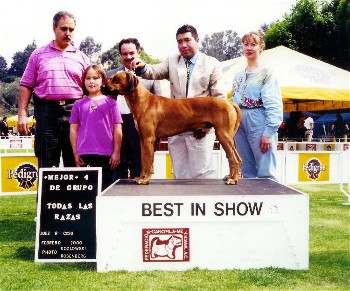 |
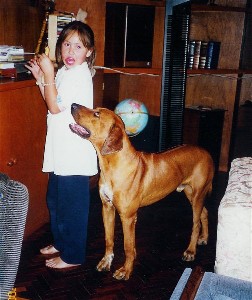 |
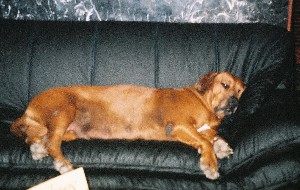 |
|
|
Shumba wining as usual |
|
Shumba wants candy |
|
Lukila taking a nap |
|
|
|
The Rhodesian Ridgeback |
|
|
The Lion Dog |
|
|
|
We are the proud owners of two Rhodesian Ridgebacks: Azania and Togo, his son. Azania is son to Shumba and Lukila, both of whom have, alas, passed away. All the personal experiences we talk about here belong to Shumba and Lukila, the most extraordinary dogs we have ever had the privilege of knowing. This site is dedicated to their memory. |
|
|
|
Rhodesian Ridgebacks: A brief history |
|
|
|
The ancient civilizations of Egypt had strong links with certain breeds of dog as proven from paintings and artifacts of the period. A drawing dated 4,000 BC, depicts various dogs, including a drop-eared hound with a ridge on its back. This is considered the forerunner to the ancestral Khoikhoi hunting dog, known today as Rhodesian Ridgeback. |
|
|
|
The Khoikhoi or Hottentot tribe was nomadic. It originated in the southern borders of the Egyptian kingdom, probably what is now Ethiopia or Southern Sudan. Over a period of a thousand years they progressively moved south with their cattle, sheep, and ridged hunting dogs until they reached the southern tip of Africa. Vasco da Gama rounded Africa in the late 15th century, reporting dog-like animals with strange hair formations. Yes, he was reporting on the early Rhodesian Ridgebacks: "The dog with the snake on it's back! |
|
|
|
In 1651 the Dutch East India Company commissioned Jan van Riebeeck to build a refueling station at the Cape of Good Hope on the southern tip of Africa. At that time, the Dutch had the policy to improve the bloodlines of indigenous domestic animals by bringing a few selected European animals for breeding purposes. Some European sporting breeds were introduced to enhance the qualities of the Hottentot crested hunting dog. The Dutch noticed that this indigenous dog was brave and courageous, with long, thin legs, capable of high speed and endurance. It was able to cover long distances without food or water, and, most impressive of all, it was capable of cornering a lion and survive! With its short-haired coat, it was well adapted to the local climate and insects. The Dutch brought Great Danes, Mastiffs, Greyhounds, and bull breeds with them from Europe. All these breeds were very different to the same breeds of today. These were dogs that had to work, hunt, guard, and be family companions. Arab traders brought with them Salukis. All these breeds mated with the native Hottentot dog, resulting in mixed breed dogs known as Boer Honde or Boer Dogs. This interim mixed breed was the immediate forerunner of today's Rhodesian Ridgeback. |
|
|
|
The Boer Dogs born with the ridge on their backs proved better hunters than those without and this, therefore, became the determining factor in their breeding. In 1875 Reverend Charles Helm took his pack of Boer Dogs to Matabeleland (southern Zimbabwe). A famous big game hunter, Cornelius van Rooyen, stopped by the missionary and decided to take Rev. Helm's ridged dogs to hunt. Cornelius was so impressed with the pack's performance that he decided to continue their breeding personally, aiming to improve their hunting abilities even more, while maintaining the other traits of family companion and smart guard. This resulted in an agile dog with superior intelligence, a brave yet cautious, quiet hunter with excellent long distance vision and well developed olfactory senses, and a guard dog with wonderful family companion qualities. For a while these ridged dogs were known as "Van Rooyen's Dogs". Big game hunting, especially lion hunting, made hunters pay special attention to these ridged dogs, because of their superior hunting abilities, which led to the name "The Lion Dog". Most stories from the big game hunts suggest that the females were the most agile and skilled hunters, while the males were regarded as the perfect guardians. This appears to be the logical division of labor between females and males, which is why the pack is able to work so well together during the hunt. Apart from their natural hunting and guarding capabilities, Ridgebacks also possess good herding instincts, which compliment their effectiveness as a pack during the hunt. This is also the reason why Ridgebacks are so well suited in guarding livestock. |
|
|
|
Whenever we go to Acapulco for the weekend, the dogs, being part of our family, come along. Our house needed maintenance, so we had two crews working in two different levels. Around 3 PM we left for a luncheon engagement (Mexican time), while the workers remained working under the supervision of our recently hired caretaker. The dogs stayed home as well. When we returned around 8 PM, we were so surprised to find the workers still working! Wow!, that was certainly unusual. They usually leave at 5 PM. What in the world happened? |
|
|
|
This we found out later from the workers and the caretaker (who unfortunately left the next day). It turns out that as soon as we left, Lukila, Shumba and Azania took upon themselves to guard the strangers that were making such a racket. The two males (Shumba and Azania) took up guarding positions with each group of workers and the female (Lukila) patrolled back and forth between the two groups, as well as checking up on the caretaker and his family. When it was time to leave, the workers began packing their tools into their backpacks, the two males, who were previously just lying there watching them work, became alert and started growling as the workers attempted to leave! The caretaker tried to intervene to control the dogs, but Lukila chased him and his family back to their living quarters. This arrangement was maintained from around 5 PM, when the workers were supposed to leave, until our arrival three hours later, at which time Lukila allowed the caretaker to leave his room and open the door for us! The workers also said that the female was barking at them until they begun working again! When she made her rounds and found a worker idling around, she would bark at him until he started working! The amazing thing is that we never taught this behavior to the dogs! They think of themselves as part of the family, their behavior is thus an extension of that belief, their superior intelligence and natural instinct to maintain their prey in one place until their master arrives. None of the workers was bitten or hurt in any way, but unfortunately most of them did not show up for work the next day. |
|
|
|
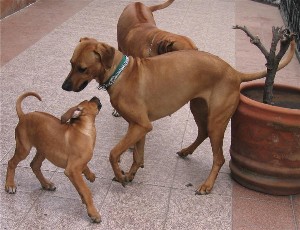 |
|
|
|
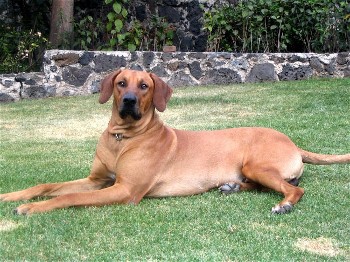 |
|
|
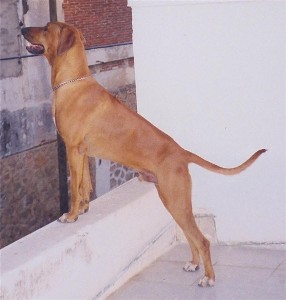 |
|
|
Shumba training Togo |
|
Azania checking out the street |
|
Togo lazing in the sun |
|
|
|
In 1922 a meeting was held in Bulawayo, South Rhodesia by Francis Richard Barnes and six other enthusiasts to discuss a standardization of this genuine African dog. The first Breed Standard was drawn up later that same year based on the Breed Standard for the Dalmatian. This standard has remained virtually unchanged with the exception of eliminating brindle as an acceptable color and the restriction of white to the feet and the chest. In 1924 the South African Kennel Union officially recognized the Rhodesian Ridgeback as a breed and in September 1924 the first dogs were registered. |
|
|
|
Characteristics and Temperament |
|
|
|
The Breed Standard states that the Rhodesian Ridgeback should be: Dignified, intelligent, aloof with strangers, but showing no aggression or shyness. |
|
|
|
A Ridgeback is adaptable and can be a loyal one-man dog or a perfect family pet; Their intelligence and understanding is almost human at times, and they have an independent spirit which should always be respected. The Ridgeback likes to please, but it is no slave: it will be your friend and equal, but never your slave it is too clever for that; It thinks for itself and may be quite stubborn at times! He is certainly no dog for controlling freaks. |
|
|
|
When Lukila was a puppy and we were in the process of housebreaking her, the job of disciplining her fell upon whoever caught her in the act. Whenever she felt that the disciplining was excessive or uncalled for, she would retaliate. She would enter that person closet, grab as many shoes as she could from the transgressor, and throw them out in the garden! This not only illustrates her need to be treated with dignity (at three months of age!), but also her keen sense of smell, as she only picked the shoes belonging to her aggressor! |
|
|
|
The most outstanding quality in a Rhodesian Ridgeback is pride. This is an intelligent, self-assured, independent dog, whose behavior may sometimes border on arrogance. It knows its own speed, agility, and competence which adds to its aloofness. The Rhodesian Ridgeback has a long memory, so never treat it badly. Well treated, it will become your most loyal and devoted companion.All it asks in return is some measure of loyalty and respect . |
|
|
|
Whenever we see any of Shumba and Lukilas pups, they still remember us, even after not seeing us for four years! When they see us, they become excited, jumping around and licking us. Their owners are always amazed at how well they remember us, because they only act in this enthusiastic way with them, never towards anyone else. This is a good example of this breed's remarkable memory. |
|
|
|
We gave, Sariwe, one of our puppies, to the German School Director in Mexico. Two years later we were invited for a barbecue at their place. You can see in the photo how Sariwe, who had not seen us in two years, jumped into Luis arms as she did when still a puppy! |
|
|
|
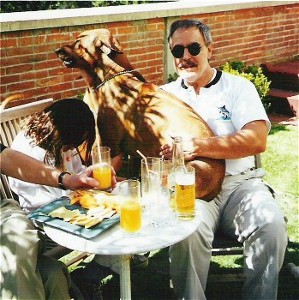 |
|
|
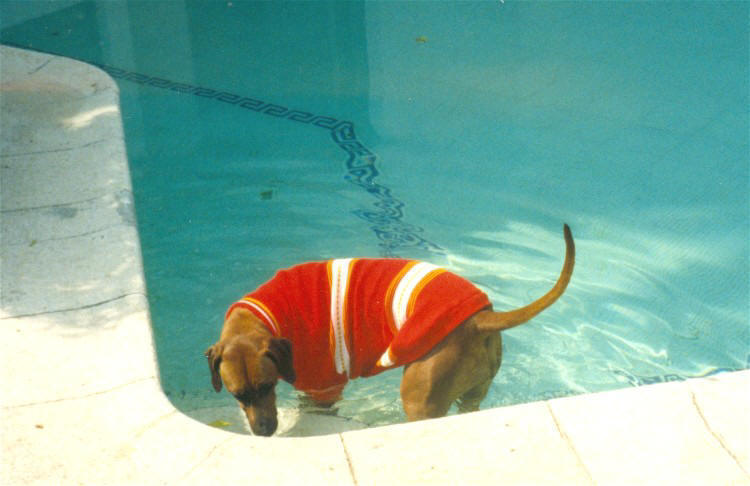 |
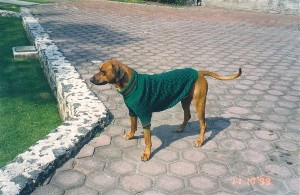 |
|
|
Sariwe on Luis' arms |
|
Lukila enjoying the pool in winter |
|
Shumba watching Lukila |
|
|
|
Ridgebacks are quiet dogs and bark only on a need to know basis, like alerting their owner that something needs investigating. Although they act aloof towards strangers, they will welcome a new face their home, only if their owner acts accordingly. If their owner feels uncomfortable or nervous, the Ridgeback will be alert, constantly keeping his body between that of his owner and the stranger. Ridgebacks have the ability to distinguish dangerous situations from those that are not, and in my experience, when your Ridgeback does not like someone, his/her instinct is usually right! |
|
|
|
Several of my friends here in Mexico have had close calls with carjacking, kidnapping, robberies, etc. We have never had a single incident. Why? Because we travel with the dogs wherever we go! Yes, they have bitten a few unsavory characters and the car is usually full of hair, but we are among the lucky few that have never faced any threat to our security! |
|
|
|
The Rhodesian Ridgeback is the most territorial of hounds, which explains why it acts aloof towards strangers: it has to protect its territory against the intrusion of strangers. A Ridgeback should be made accustomed to people and other animals from an early age so that its guarding instinct remains controlled and does not become indiscriminate, as they are naturally suspicious of things and people they don't know. Without careful socialization, they may become suspicious of everyone, which could lead to defensive biting. They can be dominant with other animals, especially with other dogs of the same sex. This is a serious, confident, and independent dog, inclined to do things its own way. Its territorial nature will cause it to test members of the family (human and animal alike) in order to find its place within the pecking order. That is why consistent leadership and obedience training is a must. Overall, the Rhodesian Ridgeback is a wonderful and capable companion for assertive owners. However, without ongoing effort, exercise, socialization, and supervision the Ridgeback can be too much of a dog, especially to an inexperienced dog owner. |
|
|
|
Whenever the dogs are alone with the maids, they do not allow them to take the garbage out of the house for pickup. The males, Shumba and Azania (this was before Togo joined in the fun), would block the door, while Lukila (the female) pushes the maid with her body to prevent her from taking the garbage bag outside. They do not bite her, but they do bark at her. This is a natural, instinctual behavior that was never taught to the dogs. They are very territorial and instinctively protect whatever is part of their territory. They also distinguish immediately who is part of the family and who is not. |
|
|
|
Young Rhodesian Ridgebacks, between the ages of 3 months to 2 years, are especially rambunctious, as they get bored easily. When bored, they can be destructive, chewing on furniture and shoes, and are also masters at the art of digging holes in the garden! Togo, who is just 18 months, is our "Gardenator", since he loves to dig holes to China and uproot any bush he deems unworthy - roots and all!! |
|
|
|
 |
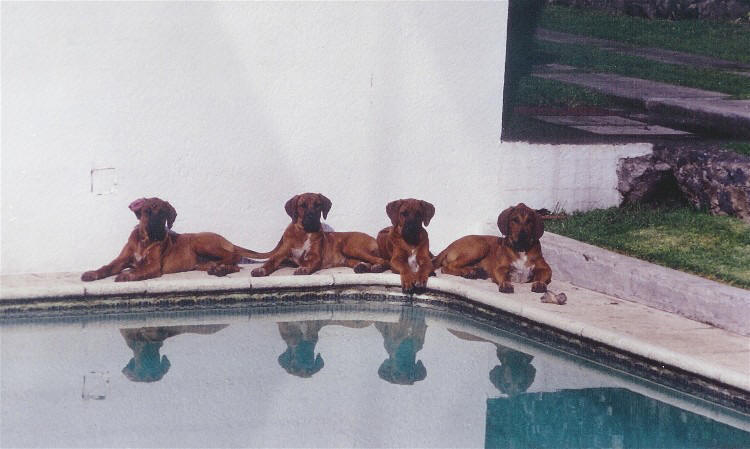 |
|
|
|
|
Pups enjoying the chairs |
|
Pups enjoying the sun |
|
|
|
Even as puppies, Rhodesians are full of inventiveness. The photos show our puppies sitting in the chairs in the patio and on the edge of the pool. Fortunately we had enough chairs and space for them, as their litters are large. When our Ridgebacks dig holes in the garden, we fill the hole back up and then put some of their fecal droppings on top of the newly filled hole. This deters them from digging in the same spot again. |
|
|
|
Male and female Rhodesian Ridgebacks have marked differences in personality and behavior, as well as mental composition. It is not that one is more intelligent than the other. No, it is just that they think differently. Males are more steady and responsible in character, without being overly aggressive. This makes the male better suited for guard work, with excellent hunting qualities. The female, although also responsible by nature, is more fun loving and playful. This sense of adventure makes the female an outstanding hunter with excellent guarding qualities. Which is better for your family? The answer is: Both, because together they balance each other very well. |
|
|
|
Lukila loved to invent games! Whenever the children were playing, she would join in wholeheartedly! A football game would become a chasing match; when kids were hitting the pi�ata, she would jump up and try to bite it. One of her favorite games in Acapulco, was to chase Ferdinand the goose into the pool, jump in after him, and swim as fast as she could to catch him. Once Ferdinand felt Lukila close, he would jump out of the pool, at which time Lukila would swim back to the pool steps, climb out and go after Ferdinand who would then jump back into the pool and the cycle would repeat itself. One time they went at it for almost two hours!. Every time Lukila would cach up with Ferdinand, she would not bite him, she would nudge him gently with her nose out of the pool!
She did not bite Ferdinand because we introduced him to all our Ridgebacks and they understood that he was part of the family. At that time we also had two cats and a ferret, and even although the dogs were not best friends with the other animals, they tolerated them as lesser members of the family! |
|
|
|
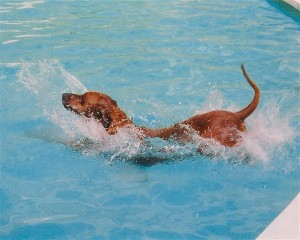 |
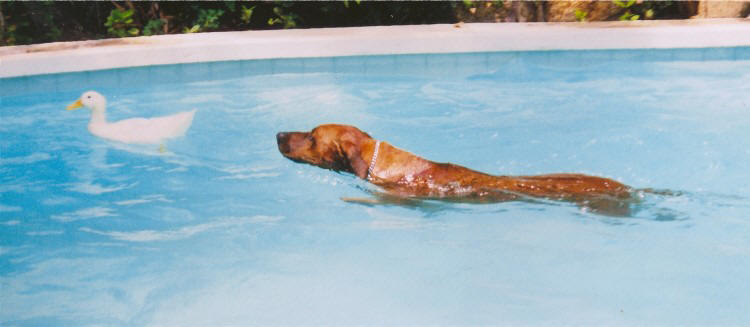 |
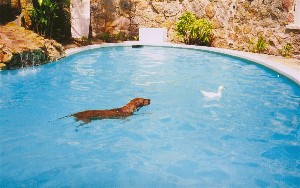 |
|
|
Lukila diving into the pool |
|
Lukila chasing Ferdinand left |
|
|
|
|
...and right |
|
|
|
|
|
The Rhodesian Ridgeback has been utilized by the police forces of many countries because of its excellent nose, speed, and agility. The Canadian Mounted Police uses the Ridgeback to rescue lost people. Rhodesian Ridgebacks have also been successfully trained as guides for blind people. |
|
|
|
Conclusion |
|
|
|
The Rhodesian Ridgeback is an intelligent, self confident, proud, independent, and dignified dog. It is loyal and devoted to its family, aloof towards strangers, and non-aggressive unless provoqued. This makes it a good guard dog and family companion. The Ridgeback's excellent sight and nose, combined with agility, speed, courage, caution, tracking abilities (both by air and ground contact), self-control, and enthusiasm make it a superior hunting companion. |
|
|
|
Owning such a versatile dog requires patience, tolerance and respect by its owner. Control will come, but this cannot be achieved aggressively. The only way to control a Ridgeback fully is to earn its love and respect. It takes almost two years for the dog to become aware he is a Ridgeback. The Rhodesian Ridgeback is a "natural breed", which means that it still possesses some of its wild and untamed traits. This, combined with its intelligence, demands large amounts of mental and physical stimulation from its owner. It is a large, energetic animal that requires certain allowances, like allowing it to enter the house and a large, fenced yard. |
|
|
|
Believe me, "once a Ridgeback owner, always a Ridgeback owner!" This fiercely loyal, intelligent, and fun-loving dog is sure to steal your heart and mind. The Rhodesian Ridgeback possesses an uncanny understanding of its owners and how they feel, not to mention its understanding of where it fits into the family hierarchy. Our Ridgebacks accept us (mother and father) as the leaders of the pack, but in their minds they have the exact same rights as the children in the family!
You can see Lukila sitting in Acapulco like a human being. Hey, if you guys sit, me too!
This empathy towards its owner is one of the many reasons why this breed is so exceptional. Their uncanny ability to sense danger and to analyze situations instantly sets them apart from many other breeds of dog. This legendary African breed is truly the Son of Africa! |
|
|
|
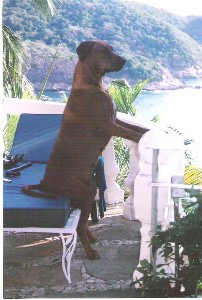 |
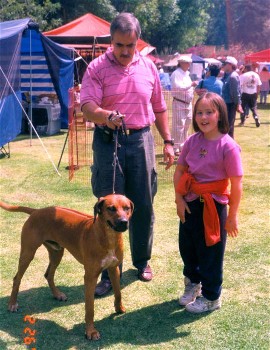 |
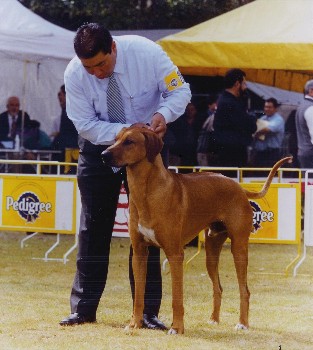 |
|
|
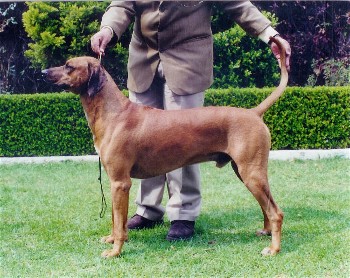 |
|
|
Lukila sitting down |
|
Shumba after winning |
|
Azania winning best of breed |
|
Shumba with his trainer showing off |
|
|
|
Addendum |
|
|
|
Shumba and Lukila were very different. Shumba loved to compete. I have never seen a dog grow in stature and float in the ring during competitions as Shumba did. He was a natural. He won almost every competition he entered. He was Mexican Champion, Grand Champion, Best of Breed, Latin-American Champion, and so on. Lukila, on the other hand, liked to make new games, play with us, swim, sit as a human and enjoy the view in Acapulco. She was not good with strangers, nor good at showing off. They both were monogamous. Really! Shumba had a lot of opportunities to breed with other bitches, but he would not. Togo is the son of Azania, Lukila and Shumba's son, because Shumba would just not mount the bitch brought for him to sire. |
|
|
|
Shumba hated staying along. Being strong willed, he would punished us when we returned by running out of the door into the street. We tried to discourage this behavior every which way imaginable, without luck. Once, after my wife returned from fetching the girls, Shumba ran out into a speeding car driven by a teenager. I took him to the doctor but he was DOA. He died the way he lived, doing what he wanted! That night, and the following day, Lukila stayed in her bed all day long and Azania cried constantly. A couple of weeks later, during a routine operation to remove her womb, Lukila died on the operating table. The vet could not explain what happened. We can, she died of sadness. |
|

















